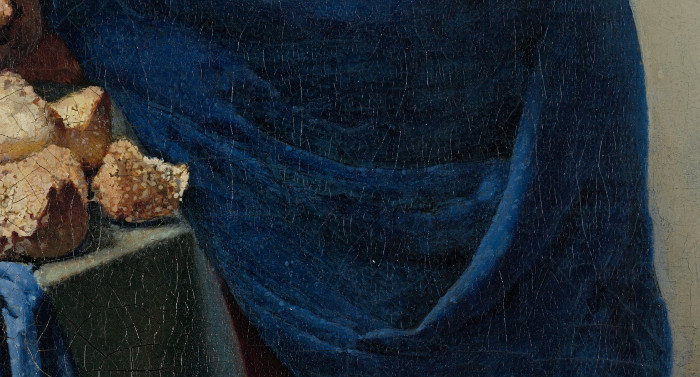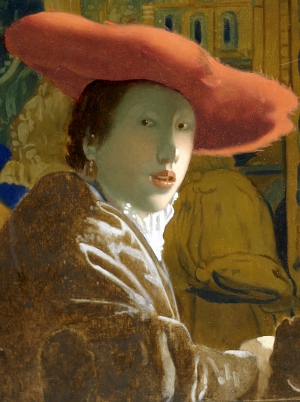Glazing is a technique that has been employed by painters since the invention of oil painting. Although in theory it is very simple, in practice glazing can be a very complex undertaking. In the simplest terms, glazing consists of applying a transparent layer of paint over another thoroughly dried layer of opaque paint, usually with a wide, soft-bristled brush. The underpainting, which is the dried layer below, is generally done in a single color but may also contain some color. The upper and lower layers of paint mix optically, not physically. Glazing is akin to placing a sheet of colored acetate over a monochrome photograph. To achieve the correct fluidity for brushing, the paint used for glazing must be modified with an oil medium. Glazing creates a unique "shine-through" or stained-glass effect that cannot be obtained through direct mixing of paint.
Glazing is a painting technique that demands a high level of skill, understanding, and patience. One of the first challenges an artist faces is understanding the inherent transparency of pigments, which varies wildly. Each layer of glaze has to be completely dry before you apply the next, which can turn the project into a long, drawn-out affair—especially when you're using oil paints that can take days to weeks to dry,. although in Vermeer's time, driers were used.
Skill and precision come next. The application of glaze requires a steady hand; apply too much, and you could suffocate the details of the layers beneath; apply too little, and the effect can be underwhelming. Even if you get the application just right, the painter still have to consider how the layers will interact. It takes a solid grasp of color theory to predict how one transparent layer will affect another.
Consistency is another hurdle. The glaze must be uniformly transparent and consistently applied across the painting for a coherent final piece.
Lastly, there's the matter of cost. The high-quality pigments and mediums required for glazing were often among the most expensive and difficult to obtain, such as natural ultramarine, which could be as costly as gold.
Why Glaze?
Glazes cannot be used indiscriminately; they were always restricted to specific passages of the composition. To begin with, there is nothing to be gained by glazing with neutral grays or dull colors. Grays are more effective when created with opaque or semi-opaque earth colors, or when black is admixed with white. The light gray background walls in Vermeer's works were never achieved by glazing. Nor were the light base tones of flesh produced by glazing transparent layers of pink over a white underpainting, as if it were a watercolor, although thin red glazes may have been used to achieve warmer variations in the cheeks and lips. There is no distinct line that separates a glaze from a semi-transparent layer of color, but in general only inherently transparent pigments are adapted for glazing. Modern art historians are apt to abuse the term and describe any layer of paint that is not completely opaque as a glaze. Brightly colored drapery were often glazed. An unfinished painting (fig. 1) by the Italian painter Andrea de Sarto shows the beginning of the working-up stage. The red drapery, which has been modeled with flat tones of vermilion and black, would have been successively glazed with madder lake. The sleeves have been modeled with light yellow and dull green and would most probably have been glazed with verdigris, a deep and lustrous green pigment.
Glazing was utilized for two reasons. One, artists of the past had very few of the brilliant colors that are available today. For instance, strong purples, greens, and oranges were either rare and unstable or could be mixed with available pigments. For example, purple was approximated by glazing blue over a reddish underpainting, or vice versa. Two, glazing creates, as we have said, an extraordinary luminosity that is impossible to achieve otherwise. Only inherently transparent pigments, called lakes, are suited for glazing. The principal pigments used for glazing were madder lake, carmine, natural ultramarine, verdigris, various organic yellow lakes and indigo. For further information on these pigments see "Vermeer's Palette."

Andrea del Sarto
c. 1527
Oil on canvas, 208 x 171 cm.
Cleveland Museum of Art, Cleveland, Ohio
Glazing, however, has more than one drawback. It is difficult to anticipate the final chromatic effect of the glazed area with respect to the overall harmony of the finished work. Due to its transparency a glaze produces an optical depth that attracts the viewer's eye more than the surrounding layers of opaque paint that usually cover the great part of painted surface of the canvas. Furthermore, it is insufficient to know how a glaze is to be applied. One has to determine with the utmost precision how thick or thin the glaze-paint should be: an application that is a little too scanty or a trifle too lavish can significantly alter a paint layer's color or tonal value. The same holds true for the underpainting, which is usually finalized in detail because, once glazed, it is difficult to correct. For these reasons glazing was not used for other than specific areas of the painting.
Today, various informative studies refer to glazing in Vermeer's paintings. However, art historians tend to overstate Vermeer's use of glazing and do not distinguish between glazing used as a corrective measure—very light glazes meant to alter only slightly the underlying paint layer that, for one reason or another, did not meet the painter's original expectations. Instead, true glazing aims to deliberately create a specific and otherwise unachievable pictorial effect. This difference might not seem fundamental but the idea that Vermeer built up his paintings in a series of successive glazes is incorrect and creates a distorted perception of Vermeer's painting methods. An oil painting cannot be created solely through a series of successive glazes as though they were watercolor washes. In the seventeenth century, the bulk of painting was executed with opaque and semi-opaque paint layers. Glazes also attract dust due to their high oil content. Dutch painters, like Vermeer, used glazing very selectively, following well-known formulas.
A fine example of a genuine ultramarine glaze can be seen in the satin gown of Woman in Blue Reading a Letter, although it is now less brilliant today due to aging of the varnish. The gem-like depth of the wrap in The Milkmaid (fig. 2) is another. In this case, the excellent state of conservation of the painting allows us to appreciate in full the chromatic brilliance of pure lapis lazuli glazed over a black and white underpainting.

Johannes Vermeer
c. 1658–1661
Oil on canvas, 45.5 x 41 cm.
Rijksmuseum, Amsterdam

A superbly conserved example of glazing can be found in Vermeer's Girl with a Red Hat. In the reconstruction to the left, various stages of the seventeenth-century multi-stage painting process can be observed. The red hat, according to common practice for painting bright red objects, is first modeled with shades of pure vermilion and black. Subsequently, the lighter areas are glazed with a thin layer of pure madder lake, while the shadowed areas are deepened with a thicker glaze that may include madder lake, black, or natural ultramarine.
The background tapestry is briskly executed using a wet-in-wet technique with various earth colors and natural ultramarine The blue satin garment, still in the underpainting stage, is modeled with raw umber and white in the highlights.